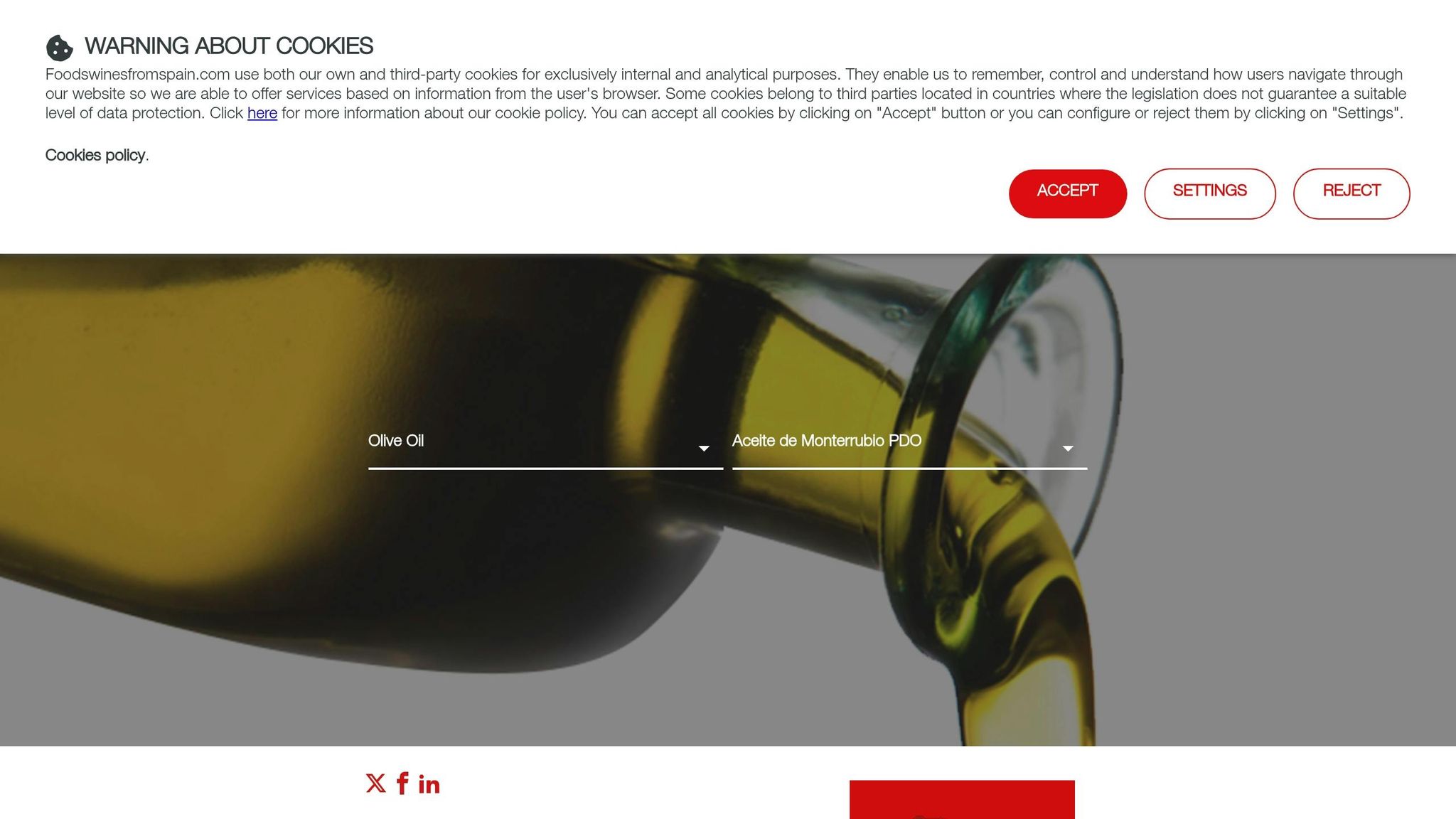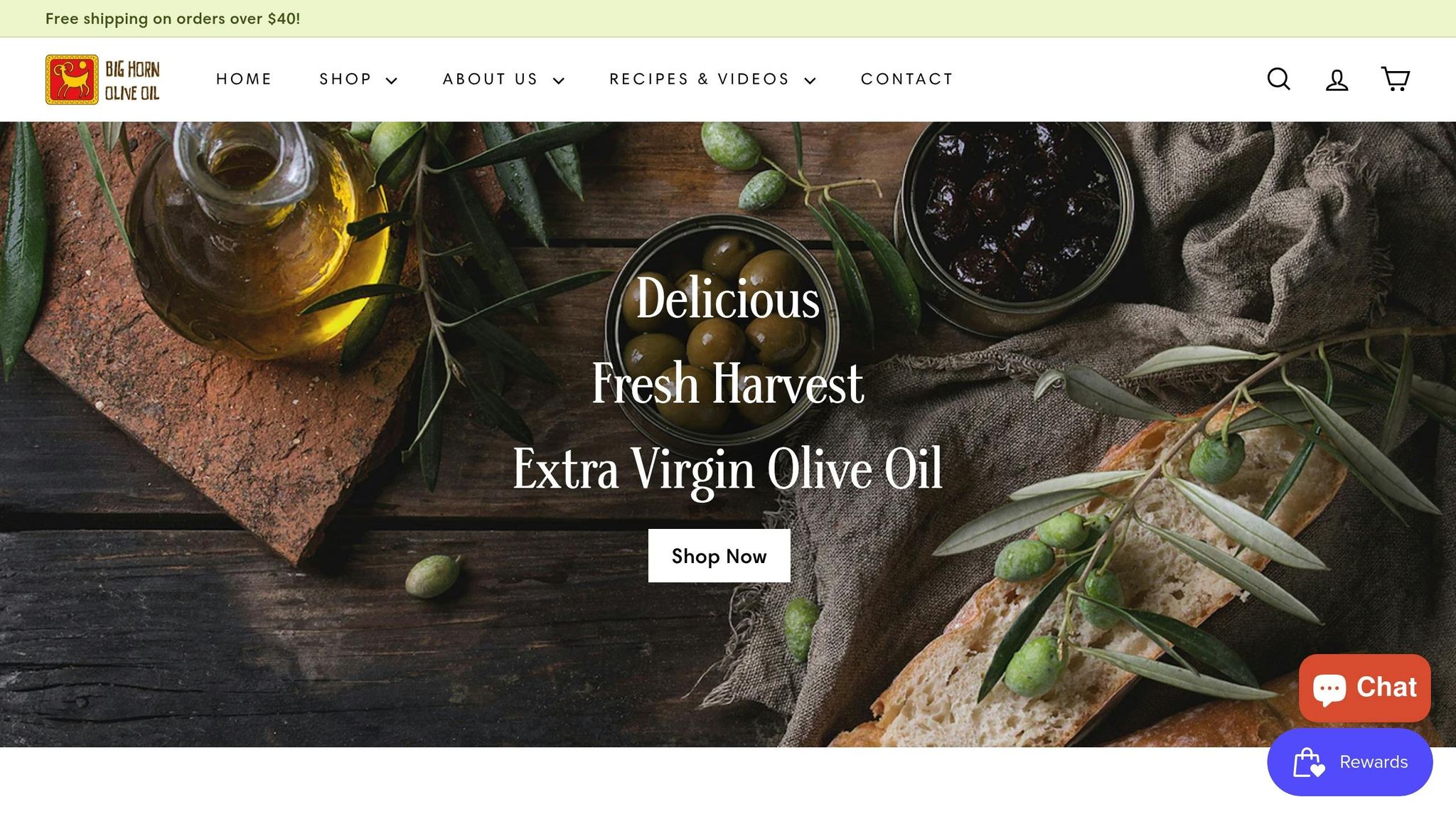Extremadura Olive Oil Regions: Overview
Extremadura is Spain's 3rd largest olive oil producer, contributing 15% of the country's output. Here's what you need to know about this region's olive oil industry:
-
Key Regions:
- Sierra de Gata: Mountainous, slate-rich soils; produces smooth, low-acidity oils.
- Monterrubio: Rolling plains; high polyphenol oils (≥450 mg/kg) with health benefits.
- Vegas Altas: Modern high-density planting in the Guadiana River valley.
- Production Stats: Over 300,000 hectares of olive groves produced 100,000+ metric tons in 2024, generating $860 million annually and supporting 50,000+ jobs.
- Organic Farming: 30% of farms are organic-certified, using modern methods like drone-based soil analysis and cold extraction.
-
Olive Varieties:
- Manzanilla Cacereña: Mild, smooth oils from Sierra de Gata.
- Cornicabra: Bold, peppery oils from Monterrubio.
- Verdial de Badajoz: Balanced oils from Vegas Altas.
- Cooking & Smoke Point: High-quality oils have a smoke point of 410°F, suitable for sautéing, roasting, and baking.
- Exports: U.S. demand grew 22% in 2024, highlighting global appreciation for these versatile, high-quality olive oils.
| Region | Key Feature | Olive Variety | Flavor Profile |
|---|---|---|---|
| Sierra de Gata | Mountainous, slate-rich soils | Manzanilla Cacereña | Smooth, mild, low acidity |
| Monterrubio | High polyphenol content | Cornicabra | Bold, peppery |
| Vegas Altas | High-density planting methods | Verdial de Badajoz | Balanced |
Extremadura blends tradition with modern innovation to produce some of Spain’s finest olive oils. Perfect for both everyday cooking and gourmet dishes.
History of Olive Growing
Early Olive Growing
Olive cultivation in Extremadura has a long history, rooted in manual techniques passed down through generations. These early methods laid the groundwork for the advancements seen in today's production processes.
Current Production Methods
Today, olive oil production combines age-old traditions with modern technology to improve both efficiency and quality. Mechanized harvesting, centrifugal extraction, and precise temperature control are now standard practices to ensure the best results.
Here’s a comparison of traditional methods versus modern techniques:
| Production Aspect | Traditional Method | Modern Technique |
|---|---|---|
| Harvesting | Done by hand | Mechanized harvesting |
| Pressing | Conventional pressing | Centrifugal extraction |
| Temperature Control | Natural conditions | Controlled environments |
| Quality Testing | Visual inspection | Laboratory analysis |
These advancements have elevated the production of extra virgin olive oil. Many oils now boast a smoke point of 410°F (210°C) or higher. Additionally, modern filtration methods help extend shelf life without compromising the oil’s natural properties. Most oils reach consumers just 1–3 months after harvest, ensuring freshness and flavor.
Asi se hace Aceite de oliva virgen Extremadura // How it's made -Virgin olive oil
Main Production Regions
Extremadura's olive oil production thrives in three primary regions, each contributing unique qualities to the area's olive oil heritage. These regions reflect a blend of time-honored practices and modern techniques, showcasing the distinctiveness of Extremadura's oils.
Sierra de Gata Region
Located in northern Cáceres, the Sierra de Gata region features mountainous terrain ranging from 2,950 to 3,940 feet and slate-rich soils. These conditions produce oils with naturally low acidity. While rooted in centuries-old traditions, producers here use modern cold-extraction methods to maintain the oils' quality and distinctive characteristics.
Monterrubio Region

In southeastern Badajoz, the Monterrubio region is known for its rolling plains and oils with high polyphenol content (≥450 mg/kg). Producers here rely on detailed soil analysis and precise temperature control during extraction to retain these compounds, resulting in oils recognized for their health benefits.
Vegas Altas Region
Situated along the Guadiana River valley, the Vegas Altas region excels in modern high-density olive planting. Advanced tools like drone monitoring, paired with ideal growing conditions, allow for efficient cultivation without compromising quality. This area highlights how innovative methods can complement and enhance traditional olive farming.
Local Olive Types
Extremadura's olive oil tradition is shaped by three key olive varieties, each grown in specific regions and known for their distinct flavors.
Manzanilla Cacereña Olives
Grown in the Sierra de Gata region, Manzanilla Cacereña olives benefit from the area's unique mountain climate. The result? Oils that are smooth and mild, with a naturally low acidity.
Cornicabra Olives
Cornicabra olives are native to the Monterrubio region. These olives produce oils that are bold and rich in polyphenols, giving them a strong, peppery kick.
Verdial de Badajoz Olives
In the Vegas Altas region, Verdial de Badajoz olives thrive. They create oils that are well-balanced and ideal for modern high-density farming.
Together, these varieties showcase the diverse flavors and qualities of Extremadura's olive oils, each reflecting the character of its growing region.
sbb-itb-4066b8e
Cooking with Extremadura Oils
Kitchen Uses
Extremadura's olive oils are great for a variety of cooking methods, thanks to their smoke points reaching up to 410°F. This makes them suitable for everything from light sautéing to high-heat cooking.
The Manzanilla Cacereña oils, known for their mild and smooth flavor, are ideal for:
- Baking and making pastries
- Lightly sautéing vegetables
- Cold uses like salad dressings
The bold and peppery Cornicabra oils shine in:
- High-heat cooking
- Marinades for grilling
- Adding a finishing touch to hearty dishes
For a balanced option, Verdial de Badajoz oils work well in:
- Everyday cooking
- Pan-frying
- Roasting vegetables
"You can't cook with olive oil... Wrong! A high-quality olive oil will have a high smoke point. If your olive oil is burning when you bake with it, you're using a low-grade olive oil!" - Big Horn Olive Oil
Using the right olive oil for each dish can make a noticeable difference in flavor and texture.
Food Pairings
Each variety of Extremadura olive oil brings unique flavors that pair beautifully with specific foods. Here's how to match them with your meals:
| Olive Variety | Best Pairings |
|---|---|
| Manzanilla Cacereña | Seafood, light salads, white meat |
| Cornicabra | Red meat, hearty vegetables, robust soups |
| Verdial de Badajoz | Mediterranean dishes, pasta, grilled foods |
To keep your olive oil fresh and flavorful, buy only what you’ll use in a few months and store it in a cool, dark spot. The natural biophenols in these extra virgin olive oils not only add unique flavors but also improve their stability for both cold dishes and high-heat cooking.
Big Horn Olive Oil Products

Big Horn Olive Oil brings the rich tradition of Extremadura to life with its Ultra Premium Extra Virgin Olive Oil. Through a meticulous selection process, they use only the top 5% of olives from each harvest to produce their oils.
Here’s what sets their Ultra Premium EVOOs apart:
| Quality Factor | Specification |
|---|---|
| Smoke Point | 410°F or higher |
| Shipping Timeline | Within 1–3 months of harvest |
| Recommended Usage Period | Within 9 months of crush date |
| Starting Price | $8.99 |
| Olive Selection | Top 5% of harvests |
These details highlight their dedication to maintaining the high standards associated with traditional Extremadura olive oil production.
Big Horn Olive Oil prioritizes purity by never blending their EVOO with other oils. This approach preserves the authenticity that has made Spanish olive oils a global standard. With a high smoke point, their oils are perfect for a variety of cooking methods, from classic Spanish dishes to modern recipes, all while retaining key nutrients even at high temperatures.
Their commitment to excellence has not gone unnoticed. LakeTahoeGem, a Google Review Local Guide, praises their oils:
"The very healthiest oils you can buy"
To experience the best flavor and nutritional benefits, Big Horn Olive Oil advises enjoying their EVOO within 9 months of the crush date.
Summary
Extremadura has a long-standing reputation for producing some of the finest olive oils, thanks to its ideal climate, rich soil, and deep-rooted traditions.
The region’s olive oil production thrives in three key areas - Sierra de Gata, Monterrubio, and Vegas Altas. Each of these zones contributes unique olive varieties that shape the region’s distinct culinary profile. This dedication to quality ensures that Extremadura’s extra virgin olive oils stand out on the global stage.
Here’s a breakdown of what makes Extremadura’s olive oils special:
| Characteristic | Specification | Impact |
|---|---|---|
| Smoke Point | 410°F or higher | Suitable for a range of cooking |
| Quality Selection | Handpicked olives | Ensures top-tier quality |
| Peak Usability | Best within 9 months | Retains maximum flavor |
This combination of tradition and modern precision has solidified Extremadura’s leadership in Spain’s olive oil industry. Advanced production facilities ensure quality control while honoring the region's heritage.
For the best experience, use these oils within nine months of their crush date. Their high smoke point (410°F+) makes them perfect for everything from classic Spanish recipes to contemporary cuisine.
FAQs
What sets olive oils from the Sierra de Gata region of Extremadura apart?
The Sierra de Gata region in Extremadura, Spain, is renowned for producing exceptional olive oils with distinct qualities. This area is known for its mild climate and fertile soil, which create ideal conditions for cultivating olives. The olives from this region are often harvested at their peak ripeness, resulting in oils with a smooth texture and a well-balanced flavor profile.
These olive oils typically feature fruity and slightly nutty notes, making them versatile for a variety of culinary uses. Their high quality and unique taste reflect the dedication of local producers to traditional methods and sustainability, ensuring a product that stands out on the global stage.
What are the health benefits of the high polyphenol content in Monterrubio's olive oils, and how are these nutrients preserved during production?
Monterrubio's olive oils are renowned for their high polyphenol content, which offers several health benefits, including powerful antioxidant properties that help combat free radicals and support heart health. Polyphenols may also contribute to reducing inflammation and promoting overall well-being.
To preserve these valuable compounds, producers in Monterrubio carefully harvest olives at their optimal ripeness and use cold-press extraction methods. This process minimizes heat exposure and oxidation, ensuring the oils retain their natural nutrients and robust flavor. These meticulous techniques reflect the region's dedication to producing high-quality, healthful olive oils.
What makes the smoke point of olive oils from Extremadura important for cooking, and how does it compare to other oils?
The smoke point of olive oil is important because it determines the temperature at which the oil starts to break down, releasing smoke and potentially altering the taste and nutritional quality of your food. Olive oils from Extremadura, especially high-quality options like Ultra Premium Extra Virgin Olive Oils (EVOO), tend to have higher smoke points, often around 410°F or higher.
This makes them an excellent choice for a variety of cooking methods, including sautéing, roasting, and even light frying. Their higher smoke point, combined with their rich flavor and health benefits, sets them apart from many other cooking oils, ensuring both delicious results and better retention of nutrients in your dishes.

